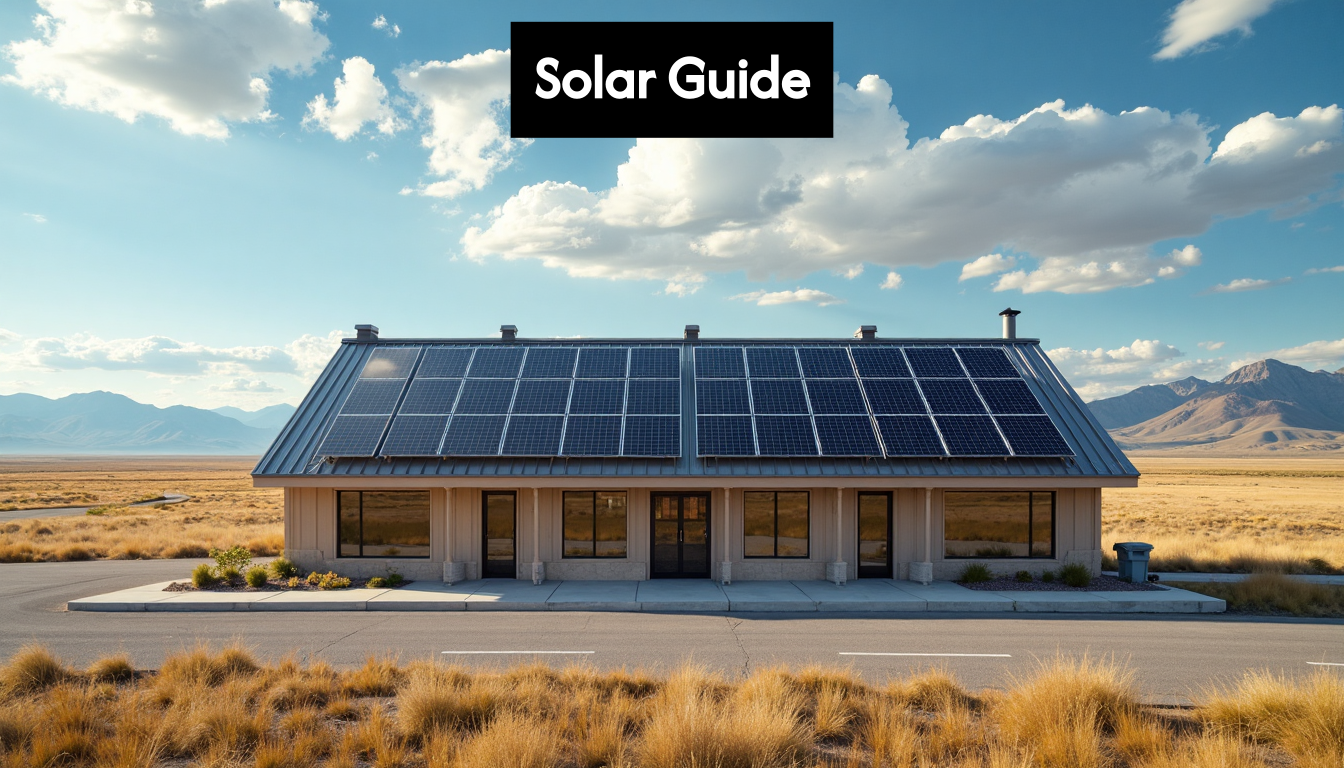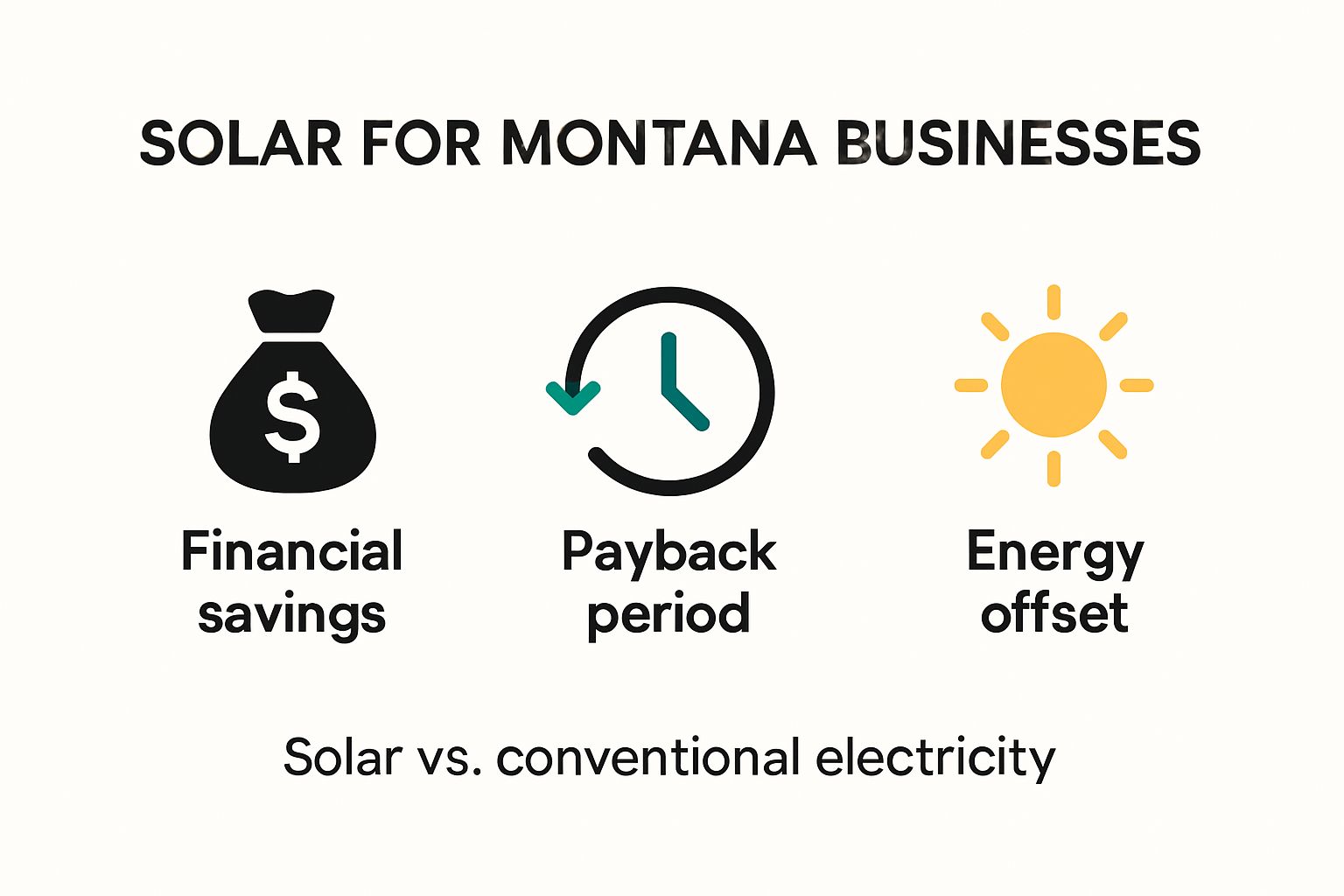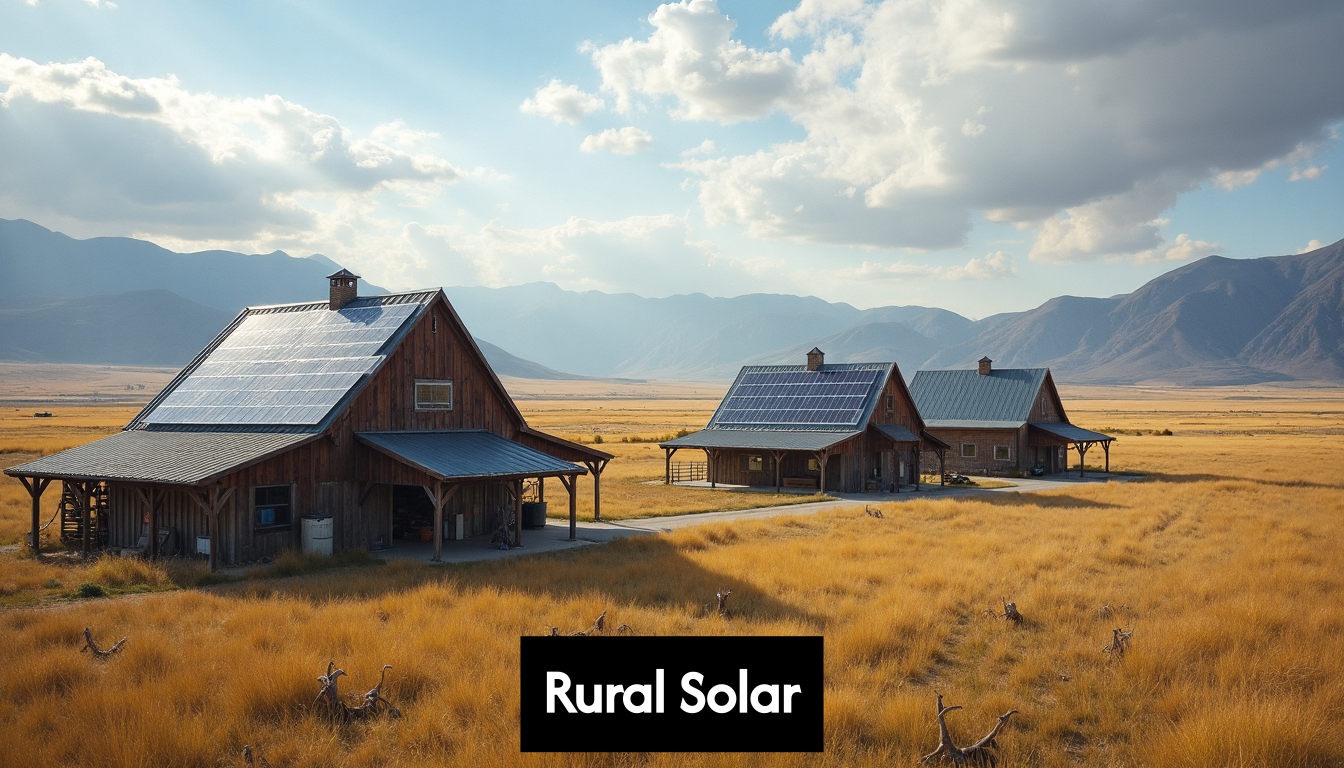Solar for Businesses in Montana: 2025 Guide to Savings & Sustainability
Contact Us

Montana business owners are realizing that solar panels can do more than shrink their carbon footprint. Here is where things get interesting. Some companies are offsetting up to 92 percent of their electricity usage and saving an average of $27,247 over 25 years just by switching to solar. Forget the old assumptions about sky-high costs and unpredictable technology. Montana’s powerful solar incentives, rugged new equipment, and specialized financing are turning remote ranches and busy storefronts alike into mini power plants. Curious how these numbers stack up and what it actually takes to get started? The real surprises lie in the details.
Table of Contents
- Why Montana Businesses Are Choosing Solar
- Financial Advantages Of Solar Adoption
- Energy Independence And Operational Resilience
- Environmental And Community Impact
- How Solar Solutions Work For Rural And Off-Grid Needs
- Overcoming Rural Energy Infrastructure Challenges
- Financing And Support For Off-Grid Solar
- Technological Adaptations For Harsh Environments
- Financial Benefits And Funding Options In Montana
- Federal And State Tax Incentives
- Specialized Financing And Grant Programs
- Long-Term Economic Analysis
- Steps To Get Started With Solar For Your Organization
- Initial Energy Assessment And Planning
- Technical Design And Financial Preparation
- Installation And Long-Term Management
Quick Summary
| Takeaway | Explanation |
|---|---|
| Significant Financial Savings | Montana businesses can offset up to 92% of their electricity usage with solar, resulting in average long-term savings of $27,247 and a payback period of about 13 years. |
| Robust Tax Incentives | Businesses benefit from a 30% federal solar investment tax credit and a 100% state property tax exemption for renewable energy systems, significantly lowering initial costs. |
| Energy Independance | Solar installations provide businesses with reliable energy sources, reducing vulnerability to grid disruptions and fluctuating utility rates. |
| Support for Rural Areas | Specialized financing options, like USDA REAP, facilitate solar adoption in rural Montana by addressing high infrastructure costs and providing loan guarantees. |
| Systematic Implementation Steps | Effective transition to solar includes conducting an energy assessment, collaborating with certified installers for technical design, and establishing monitoring strategies for performance management. |
Why Montana Businesses Are Choosing Solar
Business owners across Montana are discovering solar energy is more than an environmental statement - it's a strategic financial decision. The economic landscape for solar has dramatically transformed, making solar for businesses an increasingly attractive investment.
Financial Advantages of Solar Adoption
Montana businesses are experiencing significant economic benefits from solar installations. According to the Montana Department of Environmental Quality, companies can achieve remarkable financial outcomes. A typical commercial solar installation enables businesses to offset up to 92% of their electricity usage, translating to substantial long term savings.
The federal solar investment tax credit (ITC) provides an immediate 30% reduction in upfront installation costs, dramatically improving the financial feasibility. Businesses can expect average 25-year savings of $27,247, with a typical payback period of approximately 13 years. This makes solar not just an environmentally responsible choice, but a sound economic strategy.

Energy Independence and Operational Resilience
Beyond financial benefits, solar provides Montana businesses with unprecedented energy independence. The state's abundant sunshine creates an ideal environment for solar power generation. Energy data from the U.S. Energy Information Administration confirms Montana's solar potential, with customer-sited installations driving significant renewable energy growth in 2023.
By generating their own electricity, businesses reduce vulnerability to grid disruptions and escalating utility rates. Solar installations offer predictable energy costs, allowing for more accurate long-term financial planning. Small manufacturers, agricultural operations, and retail establishments are particularly well-positioned to leverage these advantages.
Environmental and Community Impact
Choosing solar demonstrates a commitment to sustainability that resonates with environmentally conscious consumers and employees. Montana businesses understand that renewable energy adoption isn't just about reducing operational costs - it's about contributing to a cleaner, more sustainable future.
Local solar installations support regional economic development by creating jobs, supporting local solar installation companies, and reducing overall carbon emissions. Each commercial solar project represents an investment not just in individual business infrastructure, but in Montana's broader economic and environmental resilience.
For Montana businesses, solar is no longer an alternative energy option - it's a strategic imperative that combines financial prudence with environmental stewardship. The combination of robust tax incentives, declining installation costs, and increasing energy efficiency makes solar an increasingly compelling choice for forward-thinking enterprises across the state.
How Solar Solutions Work for Rural and Off-Grid Needs

Rural Montana presents unique challenges and opportunities for solar energy implementation. Businesses and property owners in remote regions are discovering innovative solar solutions that provide reliable, sustainable power where traditional grid connections are impractical or cost-prohibitive.
Overcoming Rural Energy Infrastructure Challenges
Rural areas often struggle with limited electrical infrastructure and high transmission costs. Solar technology offers a transformative solution for these regions. The USDA Rural Energy for America Program (REAP) provides specialized loan guarantees that help agricultural producers and rural businesses invest in renewable energy systems, making off-grid solar more accessible.
Standalone solar systems can generate electricity independently, eliminating dependence on extensive transmission lines. These systems typically combine solar panels, battery storage, and inverter technology to create comprehensive energy solutions for remote locations like ranches, farms, and isolated commercial properties.
Financing and Support for Off-Grid Solar
The Montana Rural Solar Access Project (MRSAP) has identified multiple strategies to support rural solar adoption. Innovative financing mechanisms such as on-bill financing, green grants, and special improvement districts are helping communities overcome traditional barriers to solar investment.
Key financing advantages include:
- Reduced upfront costs through specialized loan programs
- Tax incentives that make solar more economically viable
- Flexible installation options tailored to specific rural environments
Battery storage technology has been particularly transformative for off-grid applications. Modern lithium-ion batteries can store excess solar energy generated during peak sunlight hours, providing consistent power during nighttime or periods of low solar generation. This capability makes solar a reliable energy source for businesses and properties in Montana's most remote regions.
Technological Adaptations for Harsh Environments
Montana's diverse landscape requires powerful solar solutions that can withstand extreme weather conditions. Solar panels designed for high-altitude and cold environments offer enhanced performance and durability. Specialized mounting systems and anti-reflective coatings help panels maintain efficiency in snow-prone areas.
Agricultural operations benefit significantly from these technologies. Solar can power irrigation systems, barn lighting, electric fencing, and other critical infrastructure without requiring expensive grid connection. Remote monitoring systems allow owners to track energy production and system performance in real-time, ensuring optimal functionality.
For Montana's rural businesses, solar is more than an alternative energy source - it's a strategic investment in energy independence. By leveraging specialized financing, advanced technologies, and tailored installation approaches, rural properties can transform their energy infrastructure, reduce operational costs, and contribute to a more sustainable future.
Financial Benefits and Funding Options in Montana
Montana businesses seeking to implement solar solutions have access to a robust ecosystem of financial incentives and funding mechanisms that significantly reduce the economic barriers to renewable energy adoption. Understanding these opportunities can transform solar investment from a potential expense into a strategic financial advantage.
Federal and State Tax Incentives
The federal solar investment tax credit represents a cornerstone of financial support for Montana businesses. According to Energy Sage, businesses can claim a tax credit equal to 30% of their solar installation costs, resulting in an average savings of $3,842 for Montana solar projects in 2025. This substantial credit directly reduces the upfront investment required for solar implementation.
Montana also offers unique property tax benefits that make solar even more attractive. Solar Reviews reports that the state provides a 100% property tax exemption for renewable energy systems. This exemption covers the added value of solar installations for up to 10 years and can shield up to $20,000 in system value from additional taxation. Businesses can essentially upgrade their property without experiencing increased property tax assessments.
Specialized Financing and Grant Programs
Beyond tax incentives, Montana offers multiple pathways for solar funding. The USDA Rural Energy for America Program (REAP) provides guaranteed loan financing and grant funding specifically designed for agricultural producers and rural small businesses investing in renewable energy systems.
Additional financing options include:
- Low-interest loans through state and federal programs
- Green bank financing with preferential terms for renewable energy projects
- Commercial Property Assessed Clean Energy (C-PACE) programs that allow long-term financing attached to the property rather than the individual business owner
Long-Term Economic Analysis
The financial benefits of solar extend far beyond immediate incentives. Most commercial solar installations in Montana generate positive cash flow within 7-13 years, after which businesses essentially receive free electricity. Energy cost savings compound over time, with many systems providing predictable, reduced energy expenses for 25-30 years.
Net metering policies in Montana further enhance the economic proposition. Businesses can receive credits for excess electricity generated and fed back into the grid, creating an additional revenue stream. These credits can offset future electricity consumption, providing a dynamic financial mechanism that continues delivering value long after the initial installation.
By carefully leveraging these financial tools, Montana businesses can transform solar from a potential expense into a strategic investment. The combination of federal tax credits, state-level incentives, specialized financing, and long-term energy savings creates a compelling economic argument for solar adoption. Forward-thinking enterprises recognize that solar is not just an environmental choice, but a sophisticated financial strategy that delivers consistent, measurable returns.
Steps to Get Started With Solar for Your Organization
Transitioning your organization to solar energy requires a strategic and methodical approach. Montana businesses can navigate this process effectively by understanding the key steps and preparing thoroughly for their solar investment.
Initial Energy Assessment and Planning
Energy Sage indicates that the first critical step is conducting a comprehensive energy usage evaluation. For most Montana organizations, this means determining the appropriate solar system size. The average electric bill in Montana typically requires a 12.6 kW solar panel system, which costs approximately $22,597 after applying the federal tax credit in 2025.Key considerations during the initial assessment include:
- Analyzing current electricity consumption
- Evaluating roof or ground space availability
- Understanding peak energy demand periods
- Identifying potential shading or structural limitations
Professional solar consultants can provide detailed energy audits that map out precise system requirements, helping organizations make informed decisions about their solar investment.
Technical Design and Financial Preparation
Montana State Solar Resources highlights that professional solar installation in Montana averages $2.54 per watt. Organizations must work closely with certified installers to develop a comprehensive system design that includes all necessary components such as solar panels, inverters, mounting equipment, and surge protectors.Financial preparation involves multiple strategic steps:
- Identifying available federal and state tax incentives
- Exploring financing options like USDA REAP grants
- Calculating potential return on investment
- Preparing documentation for tax credit applications
To claim the federal Investment Tax Credit (ITC), organizations must gather solar installation invoices and complete IRS Form 5695 with their tax documentation. This process requires meticulous record-keeping and potentially consulting with a tax professional who understands renewable energy credits.
Installation and Long-Term Management
Selecting the right solar installation partner is crucial. Organizations should request detailed proposals from multiple certified installers, comparing not just cost, but also warranty terms, equipment quality, and post-installation support. A comprehensive proposal should outline system performance expectations, estimated energy production, and projected financial savings.
Post-installation, organizations should implement a monitoring strategy to track system performance. Modern solar installations come with digital monitoring platforms that allow real-time tracking of energy production, helping businesses optimize their renewable energy strategy.
The journey to solar is more than a technical upgrade - it's a strategic decision that positions your organization for long-term financial and environmental sustainability. By approaching solar implementation systematically, Montana businesses can transform their energy infrastructure, reduce operational costs, and demonstrate a commitment to innovative, responsible business practices.
Frequently Asked Questions
What are the financial benefits of installing solar panels for businesses in Montana?
Montana businesses can offset up to 92% of their electricity usage with solar panels, resulting in average long-term savings of $27,247 over 25 years. The federal solar investment tax credit offers a 30% reduction in upfront costs, improving financial feasibility.
How do tax incentives affect the cost of solar installation in Montana?
Businesses in Montana benefit from a 30% federal solar investment tax credit and a 100% state property tax exemption for renewable energy systems, significantly lowering initial installation costs and encouraging solar adoption.
What steps should businesses in Montana take to get started with solar energy?
Businesses should begin with an initial energy assessment to determine their electricity needs, followed by technical design planning with certified installers, and finally, the installation and implementation of a monitoring strategy for long-term management.
Are there financing options available for solar projects in Montana?
Yes, Montana businesses have access to specialized financing options, including USDA REAP grants, low-interest loans, and programs like C-PACE that allow long-term financing for solar installations, making it more accessible for various enterprises.
Unlock Montana’s Best Solar Savings With Local Experts
Montana businesses face big energy challenges: rising costs, unpredictable utility rates, and the desire for real energy independence. You have read how commercial solar can offset up to 92 percent of electricity usage and save over $27,000 in the long run. But figuring out the right system size, navigating tax incentives, and choosing reliable technology for our state’s unique conditions can be overwhelming without expert help.
At Ellingson Roofing LLC, we bring every piece of the Montana solar puzzle together for you. Our local team knows how to maximize federal and state incentives, design rugged systems for rural and urban businesses, and help you lock in lower energy expenses for decades. Ready to cut your bills and take control over your energy future while these generous tax credits last? Visit Ellingson Roofing LLC Montana hub now to claim your free estimate and see how much you could save starting this year.





